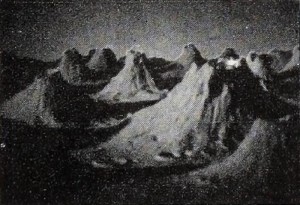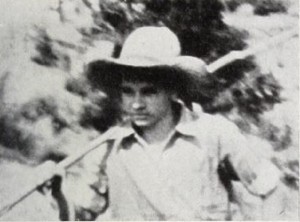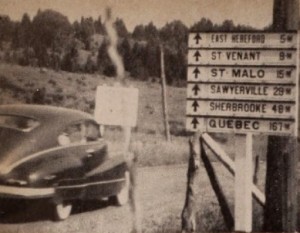
"Jack E. Gieck's film is a fanciful abstract study delineating the aspect and activity of the planet Uranus. In it he has wisely kept his footage brief. His lighting effects on models of the mountains and the color patterns of liquids reflect an imaginative concept. A rather too soft focus toward the end of Uranus is somewhat unexplainable, but his choice of an excellent musical score contributes to a fascinating creative experiment." Movie Makers, Dec. 1951, 412.
Excursión a los montes de Urbia y Aralar. El filme muestra un paisaje maravilloso por los senderos del parque natural de Aralar y una acampada en las praderas de hierba verde de Urbia, una ruta clásica entre montañeros que incluye el paso por localidades emblemáticas.
An excursion to the Urbia and Aralar mounts. The film depicts a wonderful landscape through the paths of the Aralar natural park, and a camping trip through the green prairies of Urbia, a classic route for mountaineers that includes passing through emblematic places.
Stan Midgley travels by bicycle through Utah in this "chucklelogue."

"The Utah Trail is what its producers call a "Cine Musical." In it, Al Morton and his wife have attempted to illustrate in movies a ballad which charmed them and to pay tribute pictorially to a region which they loved. They have been largely successful. The film's continuity is fluid and well integrated; the camera work is uniformly excellent and the double exposed color titles add greatly to the picture's feeling of competence and craftsmanship. Perhaps the Mortons' finest achievement in this production is the care and intelligence with which they have cut their footage to fit the ballad of their choice. The Utah Trail is a charming and colorful tribute to a well loved land." Movie Makers, Dec. 1942, 508.
A comedy about a man who, while under sedation at the dentist, dreams of a device that will make things disappear at will.
documentario"/documentary

"'Vacation Highlights,' as the title implies, is a record of a vacation trip, but instead of the usual array of catch-as-can shots which make up so many vacation record films, Terry Manos has given this excellently photographed narrative substance by employing inserts of a letter to his wife and daughter, describing his trip, and a number of tie-in shots of the two to knit the whole into a pleasant continuity. The picture is remarkable, not so much from its narrative standpoint as for its consistency in exposure. There is not a measurable difference in exposure in any scene throughout the picture. The picture depicts the start of the trip by automobile, which takes the travelers across the U.S. border into Canada and thence through the province of Quebec. On the return trip they visit such interesting sights as a wood pulp mill and the famed Ausabel Chasm, in upper New York. The camera treatment of the pulpwood sequence and of the Chasm scenes definitely mark this filmer as a photographer of promise. Manos used a 16mm. Bolex camera and Kodachrome daylight type film." American Cinematographer, Apr. 1950, 134.
Total Pages: 299